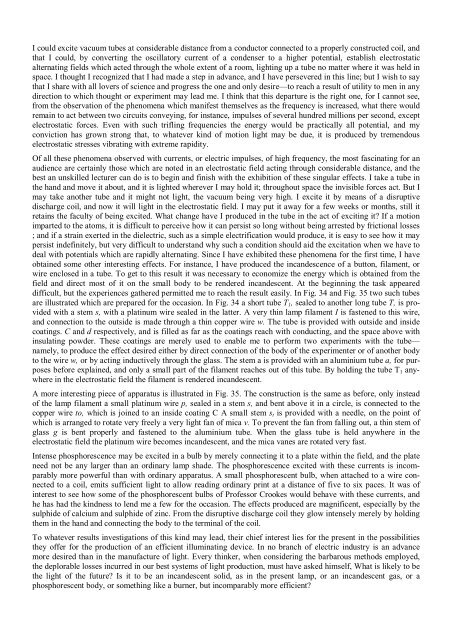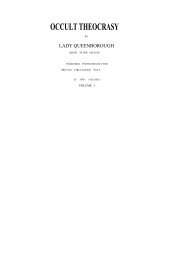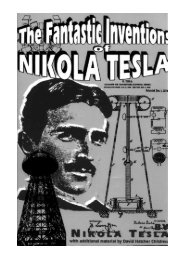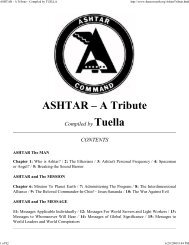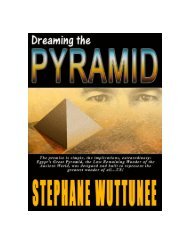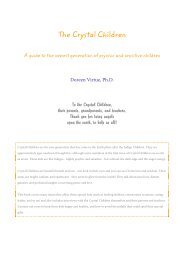the fantastic inventions of nikola tesla - Exopolitics Hong Kong
the fantastic inventions of nikola tesla - Exopolitics Hong Kong
the fantastic inventions of nikola tesla - Exopolitics Hong Kong
Create successful ePaper yourself
Turn your PDF publications into a flip-book with our unique Google optimized e-Paper software.
I could excite vacuum tubes at considerable distance from a conductor connected to a properly constructed coil, and<br />
that I could, by converting <strong>the</strong> oscillatory current <strong>of</strong> a condenser to a higher potential, establish electrostatic<br />
alternating fields which acted through <strong>the</strong> whole extent <strong>of</strong> a room, lighting up a tube no matter where it was held in<br />
space. I thought I recognized that I had made a step in advance, and I have persevered in this line; but I wish to say<br />
that I share with all lovers <strong>of</strong> science and progress <strong>the</strong> one and only desire—to reach a result <strong>of</strong> utility to men in any<br />
direction to which thought or experiment may lead me. I think that this departure is <strong>the</strong> right one, for I cannot see,<br />
from <strong>the</strong> observation <strong>of</strong> <strong>the</strong> phenomena which manifest <strong>the</strong>mselves as <strong>the</strong> frequency is increased, what <strong>the</strong>re would<br />
remain to act between two circuits conveying, for instance, impulses <strong>of</strong> several hundred millions per second, except<br />
electrostatic forces. Even with such trifling frequencies <strong>the</strong> energy would be practically all potential, and my<br />
conviction has grown strong that, to whatever kind <strong>of</strong> motion light may be due, it is produced by tremendous<br />
electrostatic stresses vibrating with extreme rapidity.<br />
Of all <strong>the</strong>se phenomena observed with currents, or electric impulses, <strong>of</strong> high frequency, <strong>the</strong> most fascinating for an<br />
audience are certainly those which are noted in an electrostatic field acting through considerable distance, and <strong>the</strong><br />
best an unskilled lecturer can do is to begin and finish with <strong>the</strong> exhibition <strong>of</strong> <strong>the</strong>se singular effects. I take a tube in<br />
<strong>the</strong> hand and move it about, and it is lighted wherever I may hold it; throughout space <strong>the</strong> invisible forces act. But I<br />
may take ano<strong>the</strong>r tube and it might not light, <strong>the</strong> vacuum being very high. I excite it by means <strong>of</strong> a disruptive<br />
discharge coil, and now it will light in <strong>the</strong> electrostatic field. I may put it away for a few weeks or months, still it<br />
retains <strong>the</strong> faculty <strong>of</strong> being excited. What change have I produced in <strong>the</strong> tube in <strong>the</strong> act <strong>of</strong> exciting it? If a motion<br />
imparted to <strong>the</strong> atoms, it is difficult to perceive how it can persist so long without being arrested by frictional losses<br />
; and if a strain exerted in <strong>the</strong> dielectric, such as a simple electrification would produce, it is easy to see how it may<br />
persist indefinitely, but very difficult to understand why such a condition should aid <strong>the</strong> excitation when we have to<br />
deal with potentials which are rapidly alternating. Since I have exhibited <strong>the</strong>se phenomena for <strong>the</strong> first time, I have<br />
obtained some o<strong>the</strong>r interesting effects. For instance, I have produced <strong>the</strong> incandescence <strong>of</strong> a button, filament, or<br />
wire enclosed in a tube. To get to this result it was necessary to economize <strong>the</strong> energy which is obtained from <strong>the</strong><br />
field and direct most <strong>of</strong> it on <strong>the</strong> small body to be rendered incandescent. At <strong>the</strong> beginning <strong>the</strong> task appeared<br />
difficult, but <strong>the</strong> experiences ga<strong>the</strong>red permitted me to reach <strong>the</strong> result easily. In Fig. 34 and Fig. 35 two such tubes<br />
are illustrated which are prepared for <strong>the</strong> occasion. In Fig. 34 a short tube T1, sealed to ano<strong>the</strong>r long tube T, is provided<br />
with a stem s, with a platinum wire sealed in <strong>the</strong> latter. A very thin lamp filament I is fastened to this wire,<br />
and connection to <strong>the</strong> outside is made through a thin copper wire w. The tube is provided with outside and inside<br />
coatings. C and d respectively, and is filled as far as <strong>the</strong> coatings reach with conducting, and <strong>the</strong> space above with<br />
insulating powder. These coatings are merely used to enable me to perform two experiments with <strong>the</strong> tube—<br />
namely, to produce <strong>the</strong> effect desired ei<strong>the</strong>r by direct connection <strong>of</strong> <strong>the</strong> body <strong>of</strong> <strong>the</strong> experimenter or <strong>of</strong> ano<strong>the</strong>r body<br />
to <strong>the</strong> wire w, or by acting inductively through <strong>the</strong> glass. The stem a is provided with an aluminium tube a, for purposes<br />
before explained, and only a small part <strong>of</strong> <strong>the</strong> filament reaches out <strong>of</strong> this tube. By holding <strong>the</strong> tube T1 anywhere<br />
in <strong>the</strong> electrostatic field <strong>the</strong> filament is rendered incandescent.<br />
A more interesting piece <strong>of</strong> apparatus is illustrated in Fig. 35. The construction is <strong>the</strong> same as before, only instead<br />
<strong>of</strong> <strong>the</strong> lamp filament a small platinum wire p, sealed in a stem s, and bent above it in a circle, is connected to <strong>the</strong><br />
copper wire to, which is joined to an inside coating C A small stem st is provided with a needle, on <strong>the</strong> point <strong>of</strong><br />
which is arranged to rotate very freely a very light fan <strong>of</strong> mica v. To prevent <strong>the</strong> fan from falling out, a thin stem <strong>of</strong><br />
glass g is bent properly and fastened to <strong>the</strong> aluminium tube. When <strong>the</strong> glass tube is held anywhere in <strong>the</strong><br />
electrostatic field <strong>the</strong> platinum wire becomes incandescent, and <strong>the</strong> mica vanes are rotated very fast.<br />
Intense phosphorescence may be excited in a bulb by merely connecting it to a plate within <strong>the</strong> field, and <strong>the</strong> plate<br />
need not be any larger than an ordinary lamp shade. The phosphorescence excited with <strong>the</strong>se currents is incomparably<br />
more powerful than with ordinary apparatus. A small phosphorescent bulb, when attached to a wire connected<br />
to a coil, emits sufficient light to allow reading ordinary print at a distance <strong>of</strong> five to six paces. It was <strong>of</strong><br />
interest to see how some <strong>of</strong> <strong>the</strong> phosphorescent bulbs <strong>of</strong> Pr<strong>of</strong>essor Crookes would behave with <strong>the</strong>se currents, and<br />
he has had <strong>the</strong> kindness to lend me a few for <strong>the</strong> occasion. The effects produced are magnificent, especially by <strong>the</strong><br />
sulphide <strong>of</strong> calcium and sulphide <strong>of</strong> zinc. From <strong>the</strong> disruptive discharge coil <strong>the</strong>y glow intensely merely by holding<br />
<strong>the</strong>m in <strong>the</strong> hand and connecting <strong>the</strong> body to <strong>the</strong> terminal <strong>of</strong> <strong>the</strong> coil.<br />
To whatever results investigations <strong>of</strong> this kind may lead, <strong>the</strong>ir chief interest lies for <strong>the</strong> present in <strong>the</strong> possibilities<br />
<strong>the</strong>y <strong>of</strong>fer for <strong>the</strong> production <strong>of</strong> an efficient illuminating device. In no branch <strong>of</strong> electric industry is an advance<br />
more desired than in <strong>the</strong> manufacture <strong>of</strong> light. Every thinker, when considering <strong>the</strong> barbarous methods employed,<br />
<strong>the</strong> deplorable losses incurred in our best systems <strong>of</strong> light production, must have asked himself, What is likely to be<br />
<strong>the</strong> light <strong>of</strong> <strong>the</strong> future? Is it to be an incandescent solid, as in <strong>the</strong> present lamp, or an incandescent gas, or a<br />
phosphorescent body, or something like a burner, but incomparably more efficient?


